Product-Led Storytelling
10 mins read
Hate Generic B2B Content Brief Templates? Try StoryBriefs & Outlines
B2B content brief framework for crafting story-driven content that converts? See why (and how) StoryBriefs & Outlines works best.
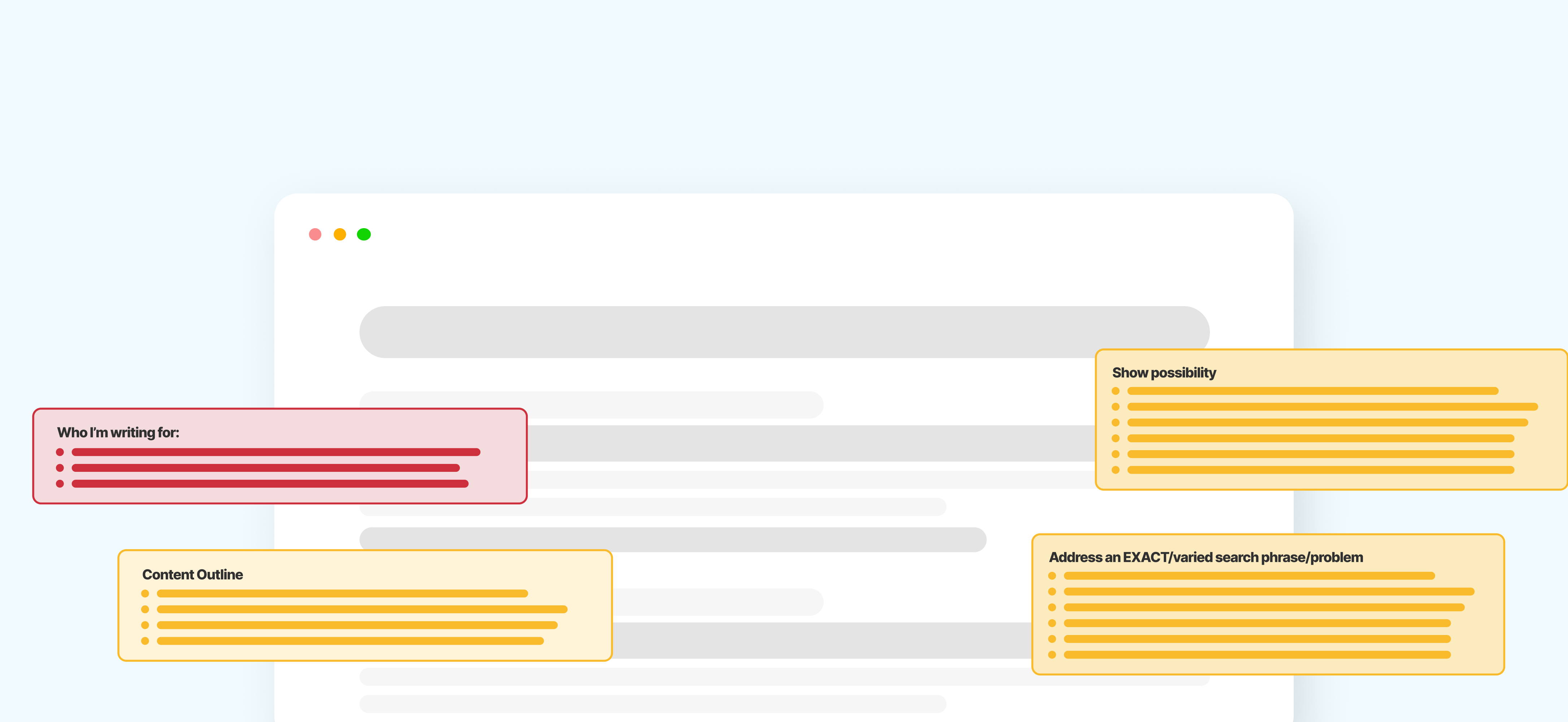

Victor Eduoh
Lead Strategist @ VEC
I’m obsessed with content consumption.
I track it every month. And each new piece we craft for clients, I strive to improve it. So much so that when HockeyStack polled B2B marketing experts (myself included) about our most valued SaaS marketing metric, I didn’t hesitate:
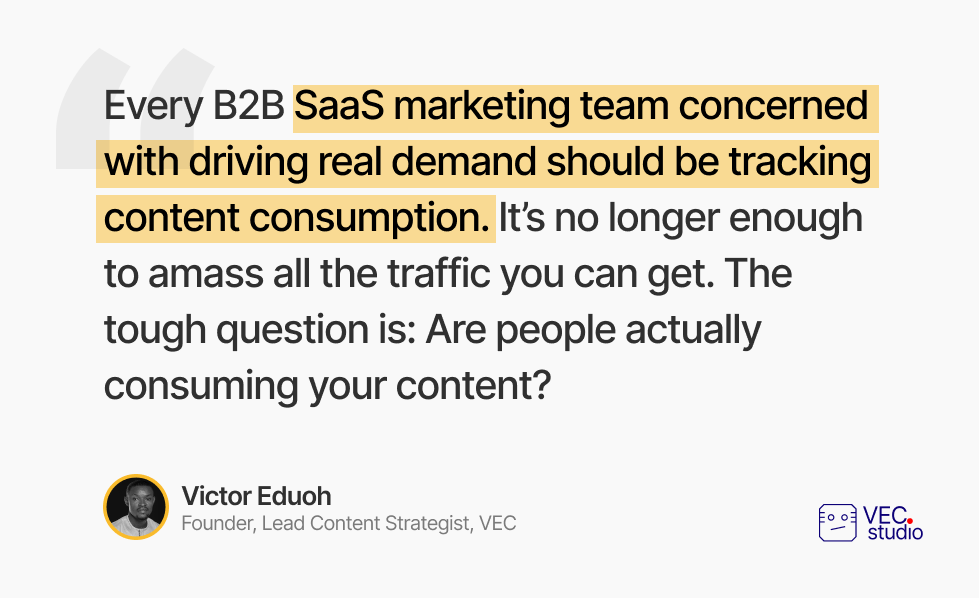
Here’s why you should obsess over it, too.
A mere 37 seconds is now the average time people spend on blog posts. That’s a far cry from TV shows and movies holding the same people’s attention for hours. It’s bad because if you can’t hold people’s attention, kiss educating them about your product’s value or capturing demand through content marketing goodbye.
So to earn attention, improve consumption time, and increase the chances of driving demand through B2B content pieces, what can we steal from movies and TV shows?
Storytelling!
As a B2B Marketer, this isn’t news. What’s new is a unique content briefing framework that guides us in crafting story-driven, product-led content. Using it helps us increase the time people spend on our articles way above the 37 secs average. For instance, in the last 30 days, our articles averaged 3–10 mins:
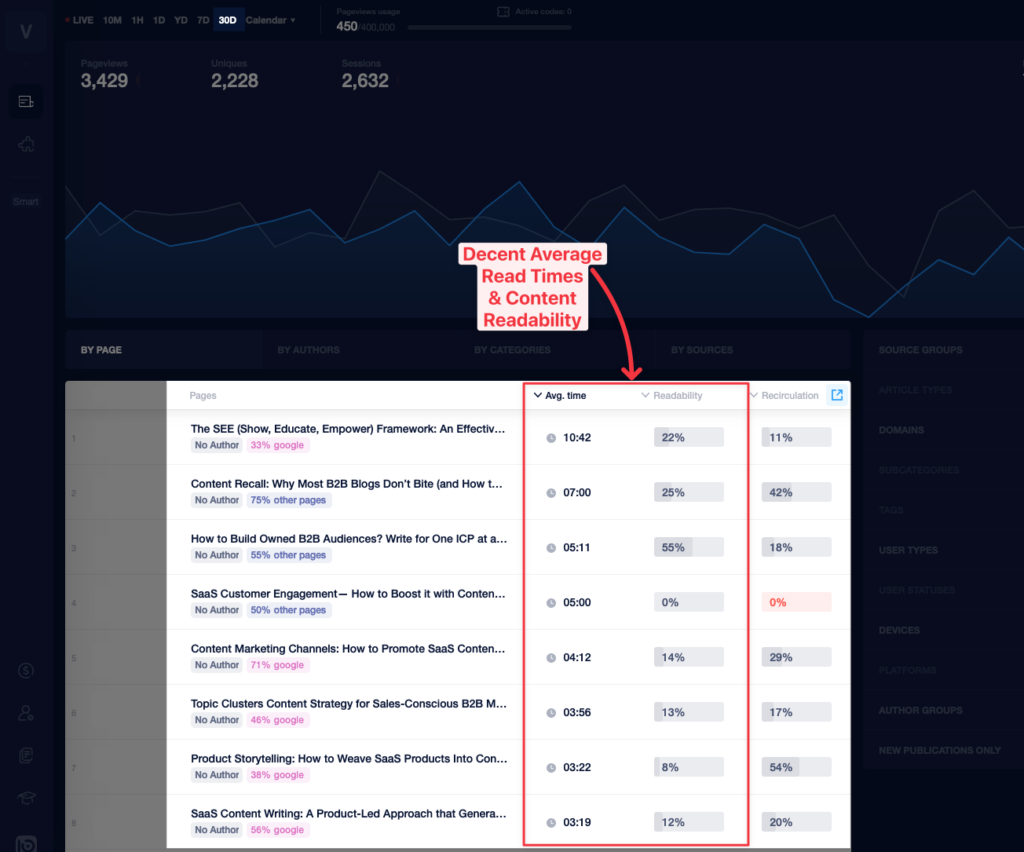
What’s the unique briefing framework helping us craft B2B content with storytelling to earn longer read times?
StoryBriefs & Outlines!
You’ll learn about it and see, step-by-step, how your team can use it today. First, we invented it after realizing that…
SEO Content Brief Templates Hamper Storytelling
A decade ago, content marketing to rank highest on the SERPs did the trick. So aided by countless SEO tools, this forced keywords into most content briefs’ titles, headings, and body sections.
This results in hyper-obsessed SEO brief templates aimed at higher search rankings with little to no room for stories that resonate with target ICPs. But by putting SEO above creating content for readers, most B2B articles lose originality and personality.
Ryan Law said it best:

Competition for the top SERPs is fiercer than ever. Readers are discovering content on channels other than search engines (i.e., dark social). And the war for attention is only getting hotter.
Due to these, the most successful B2B marketers no longer list SEO as a priority when creating content. This 2022 study by the Content Marketing Institute revealed they’re:
- Prioritizing target audience’s needs,
- Focused on differentiating their content, and
- Crafting what aligns most with buyers’ journeys:

Story-driven content personalized for target readers helps you achieve all three. Unfortunately, SEO content briefs aren’t cut out for creating such.
That’s why we designed StoryBriefs & Outlines.
Before we dive in:
StoryBriefs & Outlines: The Story-Driven Content Brief Framework
StoryBriefs & Outlines guide the crafting of story-driven content personalized for well-defined ICPs. It has room for a target keyword per piece, but the focus is not to tick SEO boxes. It is more about using storytelling to address target readers’ beliefs and pain points while painting a picture of their desired transformation.
That’s the ‘StoryBrief’ part (in red):
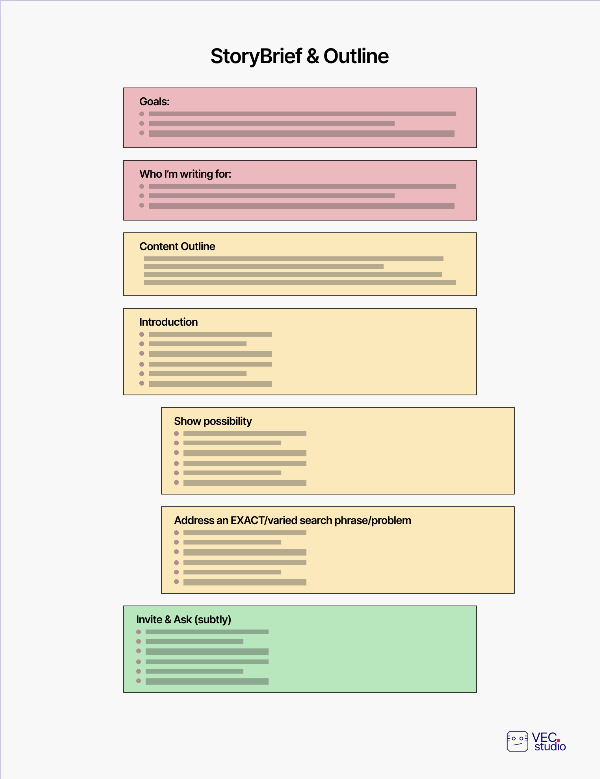
The 2nd part (yellow-green), as the name goes, ‘Outlines’ how the story in a piece should flow. Based on a target reader’s likely buyer journey stage, it uses related keywords and search queries in outlining a draft.
Before I walk you through how to create StoryBriefs & Outlines, it is crucial to note that they go hand-in-hand with ICP StoryScripts.
Creative, relatable stories are made up of characters.
So even for B2B SaaS articles, you must think deeply about your lead character (i.e., your target ICP). They do this in TV shows and movies where we’re stealing our creative storytelling elements.
For instance, Brian Ackley knows a lot about storytelling. He is One Way or Another Productions’ Head of Development. And ‘ALIENATED,’ his 2nd feature film, won 13 film festival awards.
In a piece for ScreenCraft, Brian wrote:
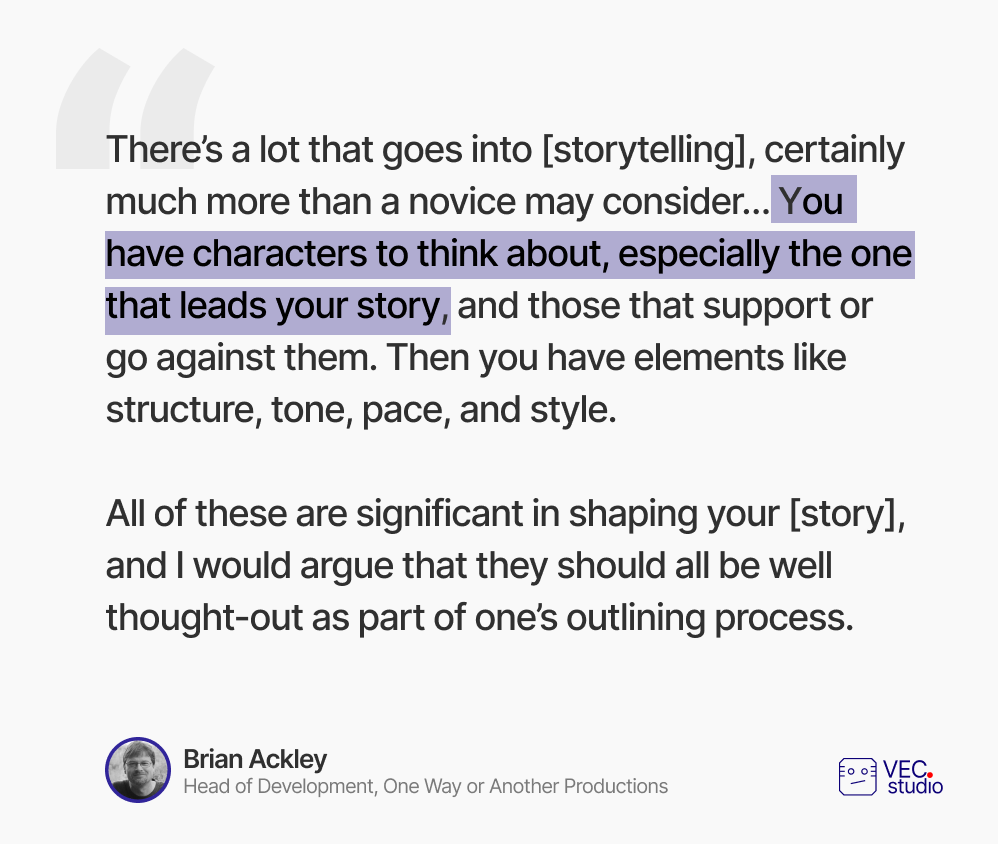
Likewise, in a story-driven content approach, ICP StoryScripts help you think deeply about the character (or target reader) you must appeal to when briefing content.
Per our definition:
ICP (ideal customer persona) StoryScripts fuses buyer personas and the jobs-to-be-done (JTBD) theory into scripts that guide the creation of contextual, story-driven marketing content.

But why should you even care?
Well, StoryScripts are powerful. They enable you to articulate WHO your ICPs really are, WHAT their pain points are, and their WHY (i.e., their desired transformations):
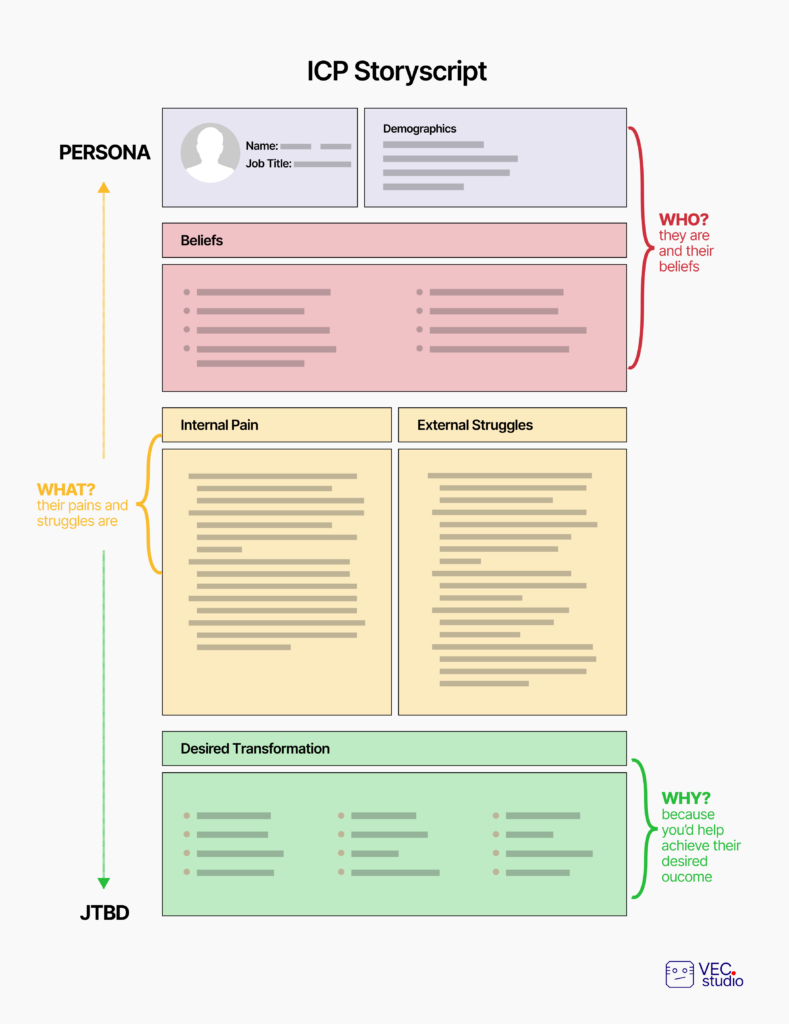
These insights make building StoryBriefs & Outlines easier. You can quickly come up with scripts to anchor and ensure the storytelling in your draft resonates with target ICPs.
Take this piece you’re reading.
Building the StoryBrief & Outline, I chose relevant scripts. Look closely, and you will notice from my intro down to the last paragraph, the storytelling in this piece anchors on:
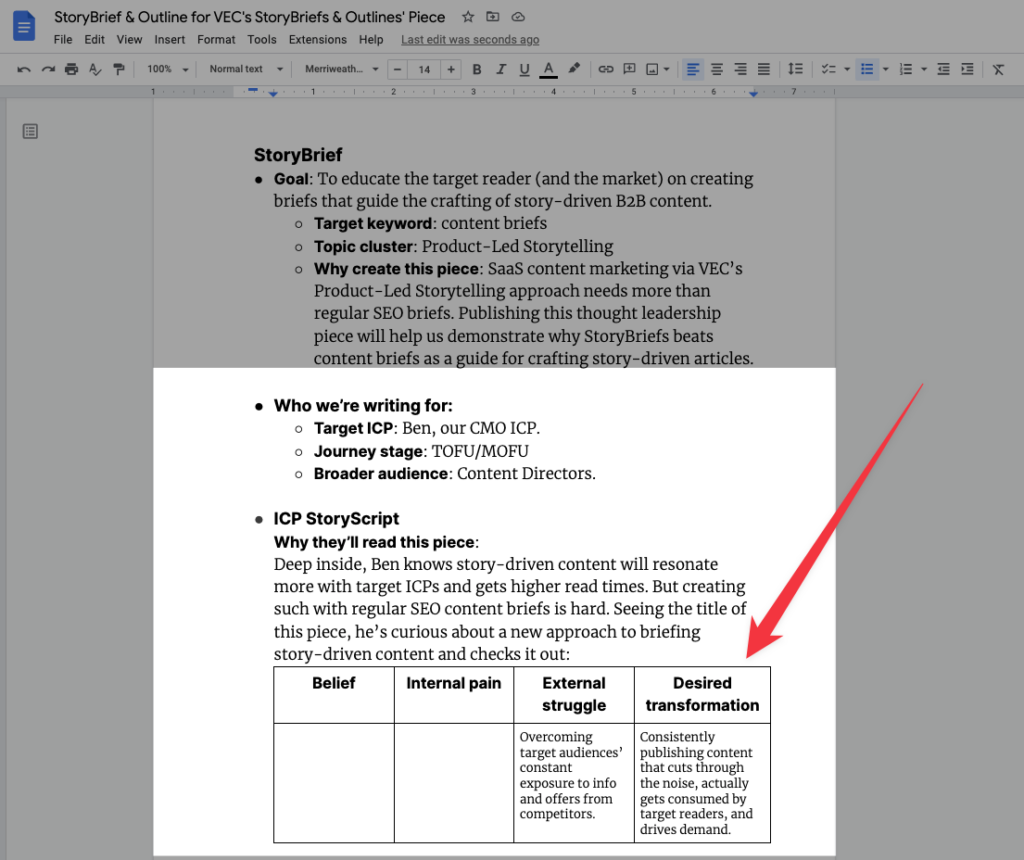
Does all these look interesting?
My self-paced online course details how to create ICP StoryScripts, build StoryBriefs & Outline, and teaches you how to combine both for crafting story-driven, product-led content.
A sneak peek at the course here:
How to Build StoryBriefs & Outlines
A StoryBrief & Outline, as shown so far, has two parts.
The 1st, ‘StoryBrief,’ has seven sections, while the 2nd, ‘Outlines,’ has nine steps per our Product-Led Storytelling content execution approach.
Let’s briefly explore what goes into creating each section.
Part I: Creating the StoryBrief
The seven sections in this part are:
- The article’s goal,
- Target keyword,
- The topic cluster the article fits into,
- Why your company needs the piece,
- Who you’re writing for and their buyer journey stage,
- ICP StoryScript alignment, and
- Relevant, related keywords and search queries.
1-4 keeps the briefing of new articles aligned with your content marketing (and overall marketing & business) strategy.
Here’s how.
Stating a high-level, mutually beneficial goal for your company and target audience sets you on the right path. Next is ensuring each piece targets a keyword, fits into a topic cluster, and clarifies why creating is beneficial.
5–6 forces you to think deeply about the target reader.
Information is good for all. But for relatable storytelling, you must choose your character (i.e., who you’re writing for). Follow that up with their likely buyer’s journey stage and the immediate audience who could also relate to your story and find the content valuable.
Then you have the ICP StoryScript section.
This one requires you to empathize with the primary target reader. Essentially, why will they care about your content amidst more important things they could be doing with their time?
Succinctly and with a storytelling arc, answer that question and articulate what trigger(s) is likely to prompt them into finding and reading your piece. Complete this section by choosing, from your ICP StoryScript Doc, what belief, internal pain, external struggle, or desired transformation you’ll use relatable stories to address.
In my case, (1) external struggle and (2) desired transformation were enough for crafting personalized stories in this guide:
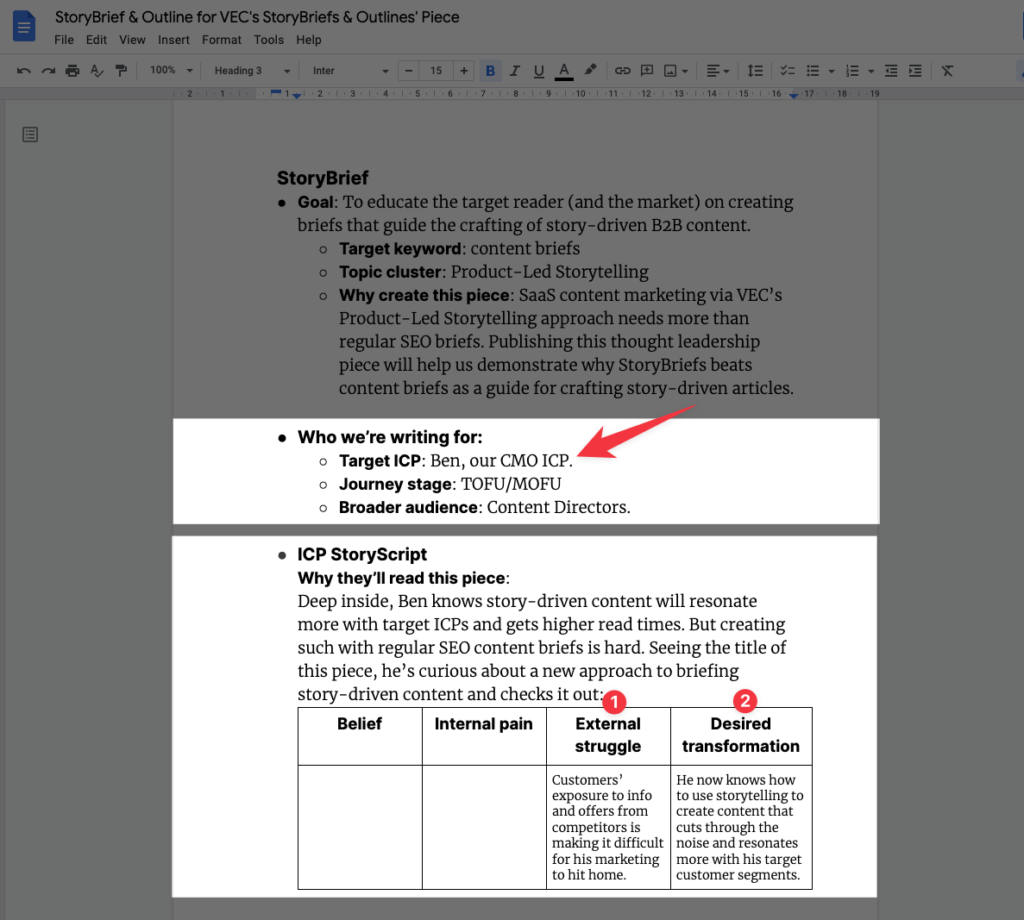
Part II: Outlining the Content
Going this length to specify target readers when briefing content does a lot. According to Meisha Bochicchio, Goldcast’s Senior Content Marketing Manager, it provides sufficient context.
In her words:
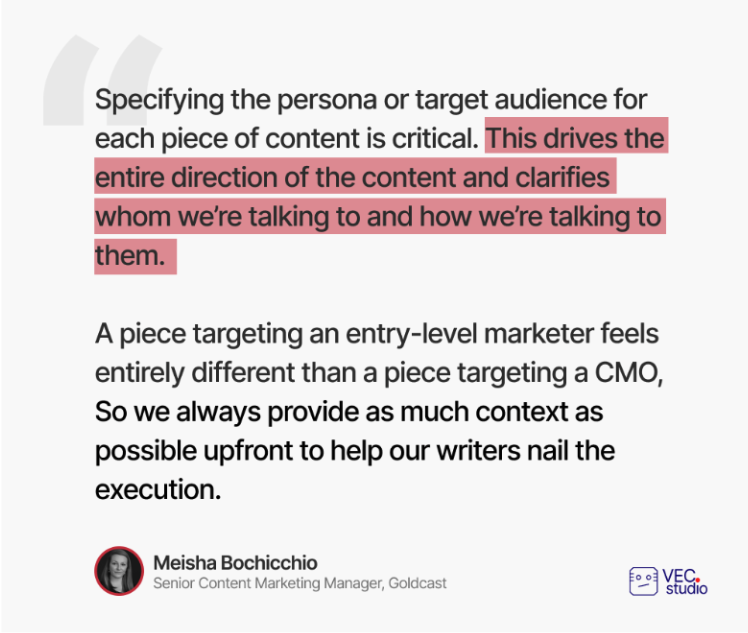
Then we have the 7th section.
Two things here, which will guide how you outline your draft, are (1) relevant, related keywords and (2) search queries. We use Google Search and SEO content tools to get data for this section.
Let’s start with Google.
Type your seed keyword into Google, scroll to the ‘people also ask’ tab, and scrape relevant queries. If you have the Keyword Everywhere plugin, you can also find related keywords:

For us, Google is a starting point.
Sometimes the data is sufficient. But SEO tools give us more keyword data and queries from community platforms like Reddit, Quora, etc., where target personas now spend time.
As a B2B content studio, we have many tools in our arsenal. We use what’s most appropriate based on the client we’re working with and each tool’s prowess. To find related keywords and relevant queries, when creating StoryBriefs & Outlines, we recommend these (NB: we’re customers, not affiliated).
- WriterZen: For finding opportunity keywords.
- Frase: For organic queries from Quora and Reddit.
- MarketMuse: For a long list of queries related to a keyword.
From data these tools provide, choose the most appropriate related keywords and search queries you’ll address when outlining your draft. Keep your choices relevant to the information outlined in the story-briefing part.
I chose these for this guide:
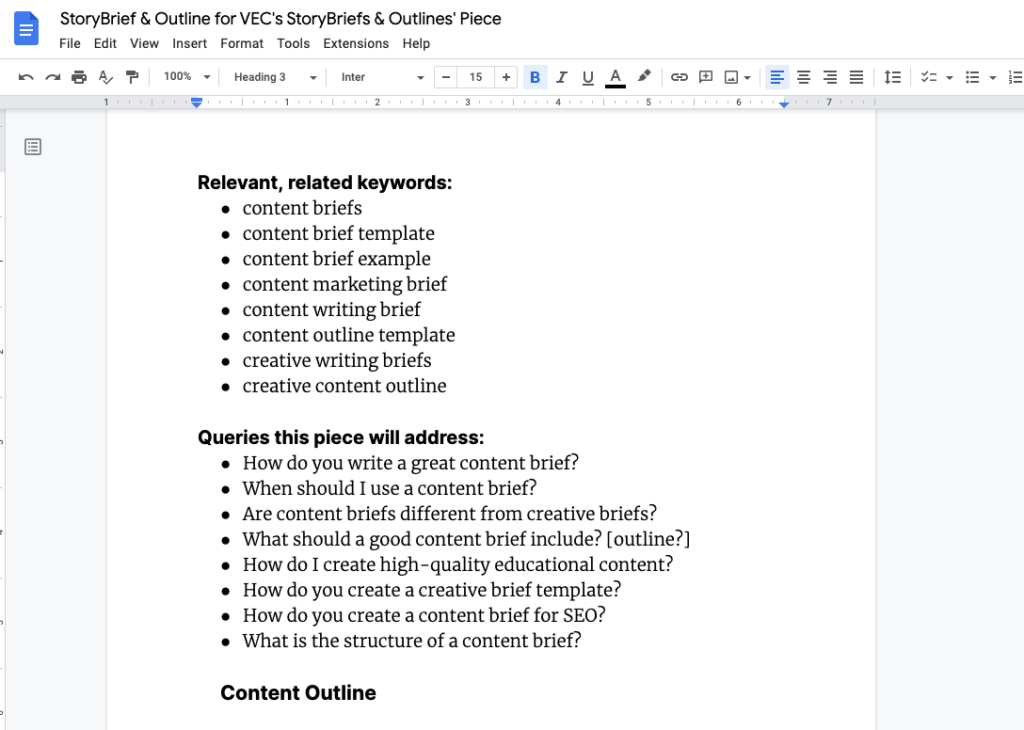
This part has nine steps corresponding to the Product-Led Storytelling content crafting framework. On the one hand, you’re using H2s and H3s to create outlines that address the keywords and queries shortlisted in the last section above.
On the other hand, these H2s and H3s serve as your creative storytelling guardrails. The entire steps to creating them are detailed in my course. Each step is crucial and leads to the next. That’s because, even though we need stories to earn attention and engage target readers, SaaS content creation is business writing.
As such, one must be guided.
Furthermore, the actual creative storytelling happens in the content’s body while addressing those H2s and H3s. Your narrative should contextualize the buyer’s journey stage and relate to the target reader’s pain points and desired transformation.
In the end, the nine outlining steps help you:
- Attract a target reader (your ICP) who has a problem,
- Pique their interest via a promising title (your content),
- Use relatable stories in the actual content writing to address their pains and show (not just tell) how to overcome their problem (with your product),
- By showing how ICPs like them overcame the same problem with your product (infusing case studies excerpts), they’re compelled to act and transform their lives, too.
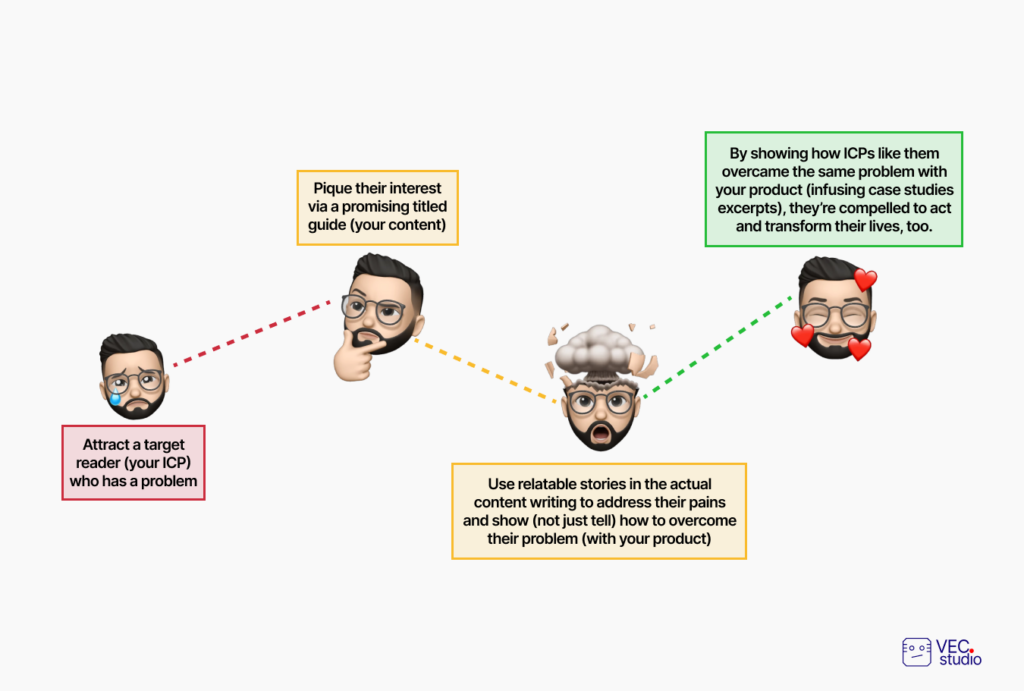
But it doesn’t end there.
The nine steps summarized above form the Product-Led Storytelling approach. And the goal, combining StoryBriefs & Outlines and ICP StoryScripts, is to transform each crafted piece into subtle sales funnels with three parts:
- Attract & Filter,
- Engage & Show,
- Persuade & Convert:
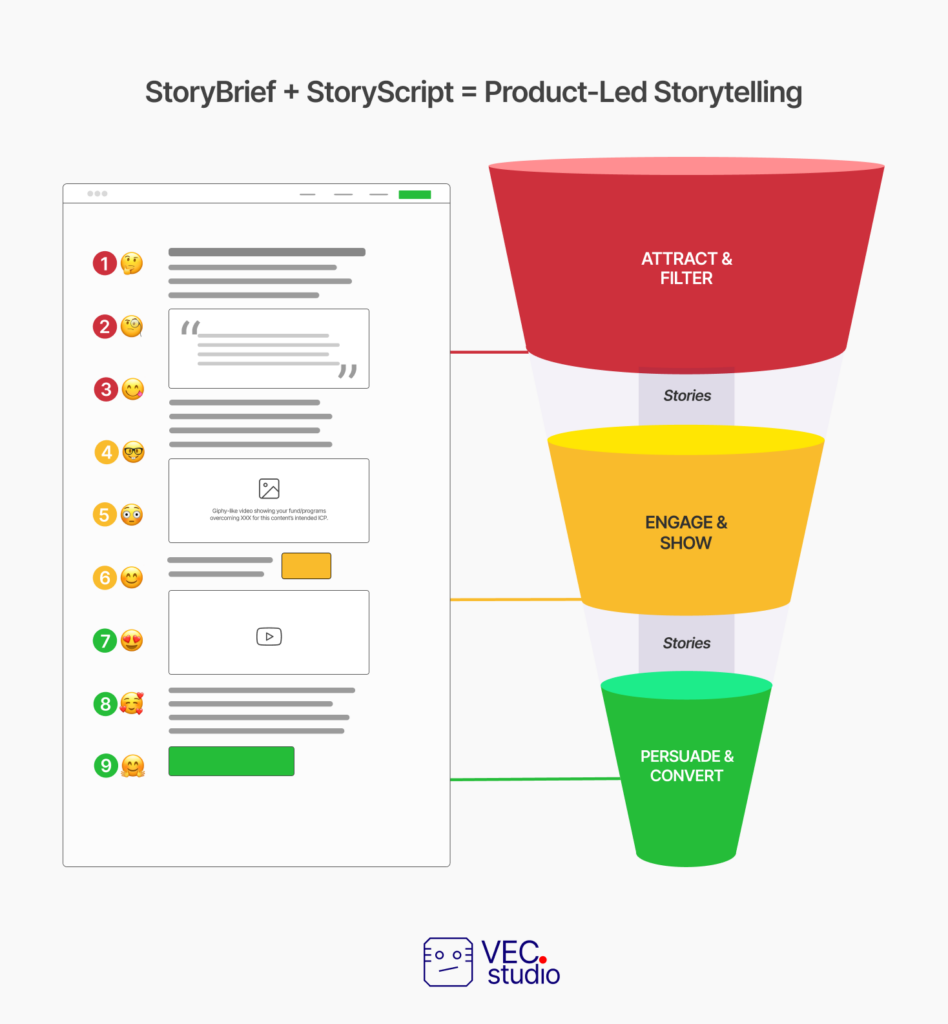
Make Crafting Story-Driven Content Easier
B2B marketers often make one mistake.
We assume because we’re selling to businesses, buyers at those companies are mostly logical when making decisions. While that’s partly the case, emotion still reigns supreme.
For instance, Nick Hague, Head of Growth at B2B International, shared insight and data, highlighting the crucial role emotion plays.
According to him:
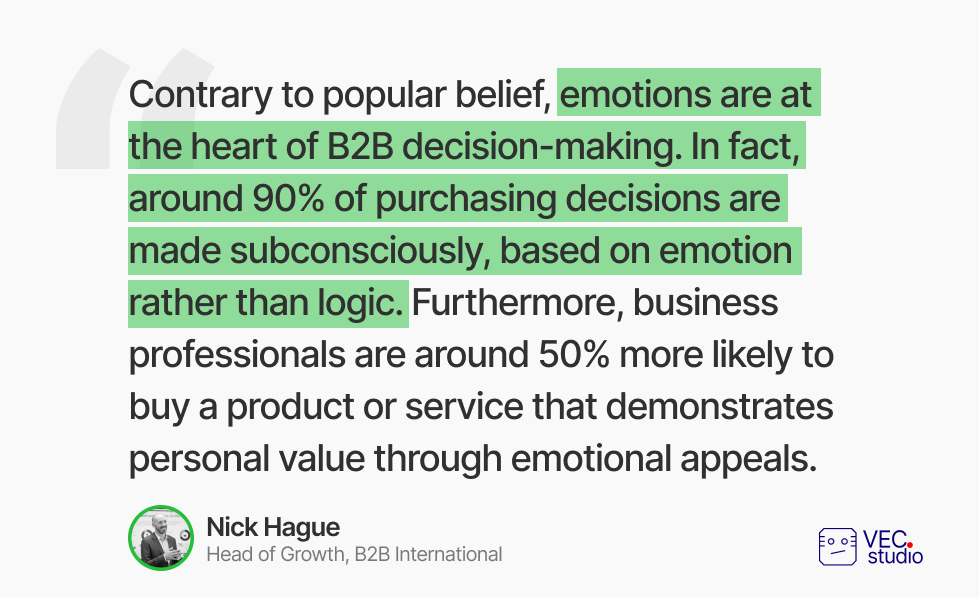
Now, here’s the question:
How do you appeal to B2B buyers emotionally and earn their attention long enough to demonstrate your product’s value?
An excellent way is to adopt a strategic, story-driven content marketing approach. But before you jump in, here’s a fair warning from the Content Marketing Institute’s recent study:
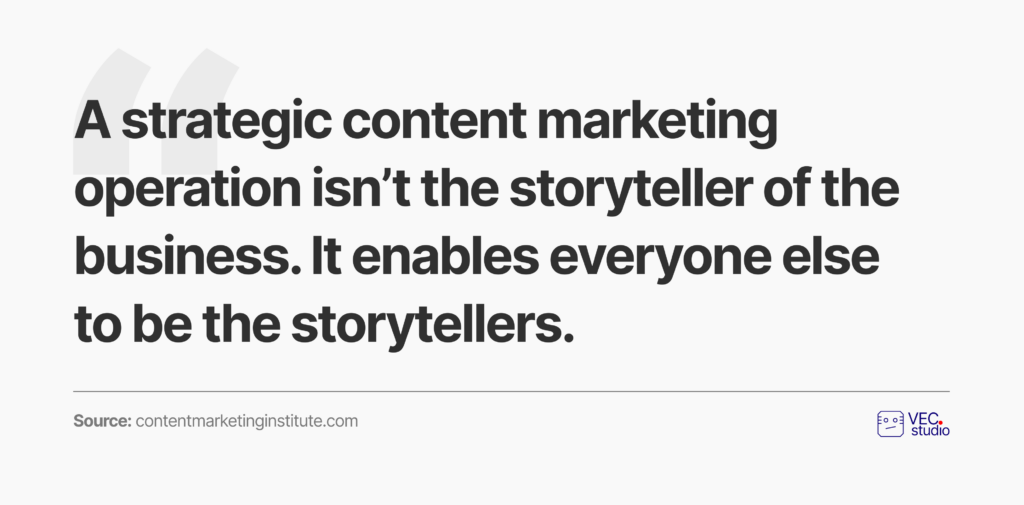
In other words, you need frameworks that enable your entire content team to become storytellers. Bland buyer personas and SEO content briefs aren’t cut out for such. So why not learn to create and use ICP StoryScripts and StoryBriefs & Outlines?
B2B marketing teams I’ve trained with these frameworks came out with the right way to craft content with storytelling:
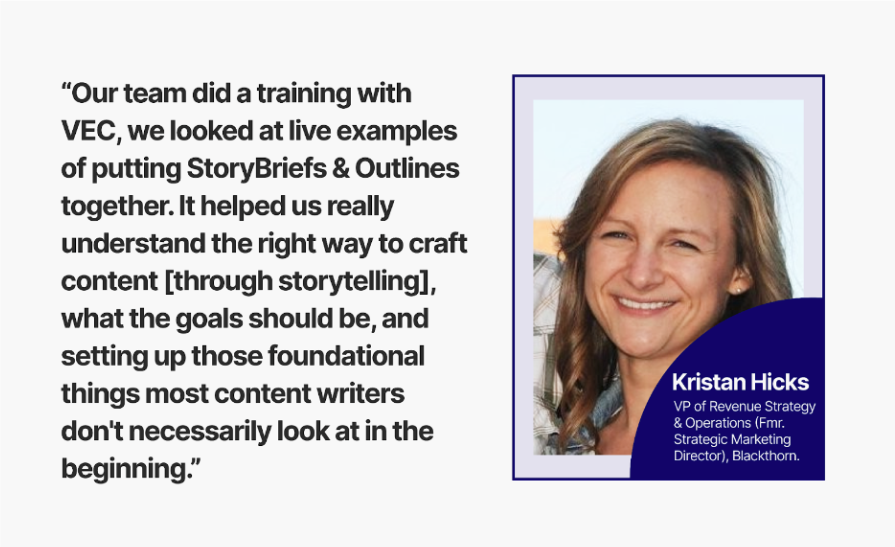
Check out the course to learn more.

Victor Eduoh
Lead Strategist @ VEC
Founder, Lead Strategist @VEC. Thinker, reader, words-crafter, and husband to Omosede. Besides crafting product-led stories, I love scouting and grooming rare marketing talents.
Rare insights, in your inbox
How do SaaS Founders and B2B Content Leaders build brand and drive growth through story-driven content execution? Dig that, plus rare Product-Led Storytelling insights, in this bi-weekly newsletter.
Get a copy of our Story-driven, Content Quality Checklist –FOR FREE– once you subscribe.

